Intel X58 Motherboard Roundup - What does $300 Get You?
by Gary Key on December 5, 2008 3:00 PM EST- Posted in
- Motherboards
ASUS P6T Deluxe
Features
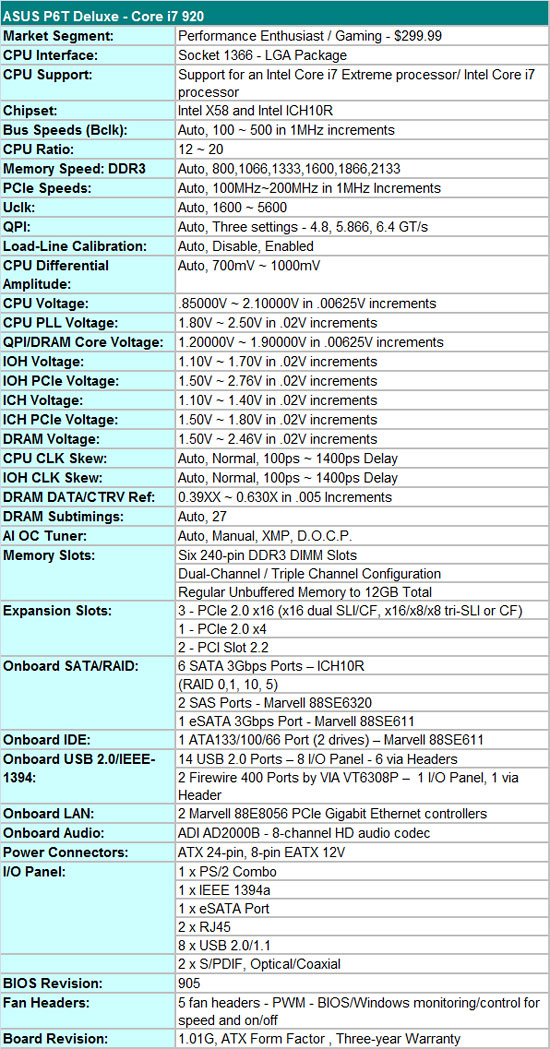
ASUS offers the P6T Deluxe in two different versions, one with the OC Palm external display module for $338 and one without for $299. The OC Palm was originally introduced as the ScreenDuo last year and features a 2.5" QVGA display, four-way directional pad, and four input buttons. It attaches to the motherboard via a USB cable and features a clean, uncluttered, and simplistic interface that allows the user to interface with various ASUS software programs. The user can monitor various hardware functions or do on-the-fly overclocking. The unit allows real-time changes to the processor's Bclk along with voltages for QPI, memory bus, and the CPU. We would like to see additional overclocking variables along with the ability to save profiles to the BIOS or real-time changes to the BIOS. Overall, it is a unique feature and fun to play with for about 30 minutes, but for most users we would suggest saving the money and buying the base board - A board that we might add is one of our favorites in the lab since it first arrived.
Not to take anything away from our other boards as they are all very good with one bordering on being great, but the ASUS P6T-Deluxe impressed us with its ability to just work as expected out of the box. While we provided several suggestions to ASUS for improvements, they mainly centered on tuning aspects, not getting basic functions to work properly before we could even consider testing. That may seem trivial, but unfortunately it is not if you are an early adopter of high-end motherboards.
The BIOS is designed for a wide variety of users who want to get the most out of a board when overclocking. Some of the voltage ranges are not as wide as Gigabyte's, nor do you have the ability to control each individual memory channel, but the options available will more than suffice for most users. We also think the ASUS BIOS is more user friendly due to the information provided for each option. However, ASUS continues to use the terminology QPI/DRAM instead of VTT as the other boards do.
ASUS features memory speeds from 800MHz to 2133MHz memory for the i920/i940 processors along with opening up QPI link speeds from a standard 4.800 GT/s up to 6.400 GT/s. We are disappointed with the number of OC profiles in the BIOS. ASUS has three OC profiles compared to up to eight on the other boards.
The board officially supports 12GB of DDR3 memory, although we expect full support for 24GB in a future BIOS release. Running 12GB of memory on this board is extremely easy and it usually requires less voltage while providing tighter timings than the other boards. Our 12GB Patriot and G.Skill DDR3-1600 kits were 24/7 stable at 1600 with 8-8-8-24 1T timings, although we needed about 1.66V for absolute stability. The Gigabyte board offered slightly better latency results with 9-8-8-24 1T timings, but the ASUS board was just slightly faster in most of the benchmarks except for WinRAR. Of course, your mileage will vary with different memory kits and sub-timings, and outside of memory benchmarks the net difference is generally less than 1%.
One last item of note, at least in this first look, is that the three PCI Express 2.0 x16 slots will operate in x16/x16 mode for 2x SLI/CF if the third x16 slot is empty. If you decide to place a PCIe RAID, network, audio, or TV tuner card in the third x16 slot, then the 2x SLI/CF configuration will operate in x16/x8 mode. We did not notice any performance differences between the two modes with our HD 4870 or GTX 260 cards. 3x SLI/CF configurations will run in x16/x8/x8 mode. You can also use the first and third x16 slots for graphics if you need to open up a PCI slot but the board will run in x16/x8 mode. Although the owner’s manual states the three x16 slots are for graphics cards only, we had no problems running our ASUS Xonar D2X or Highpoint Rocket RAID cards in x16 slot two or three.
The Board
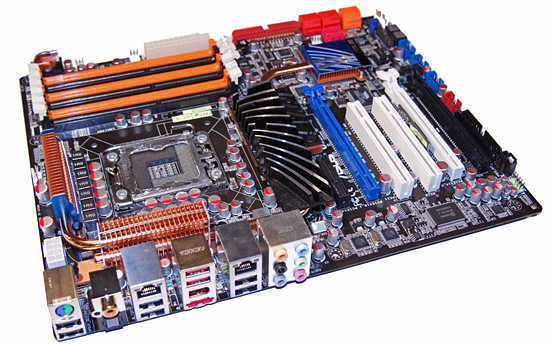
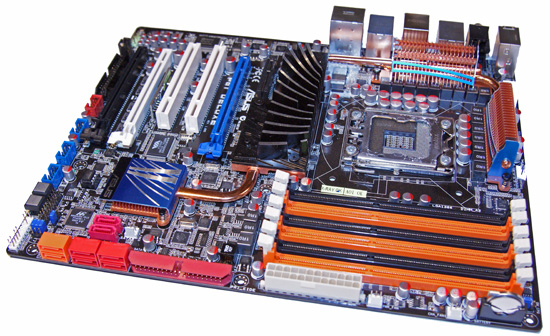
The P6T Deluxe carries over the orange and black decor from previous ASUS DDR3 boards along with a blue and white slot motif. While not exactly as colorful as previous Gigabyte boards or as subdued as the MSI board, it does work well enough; we prefer the flagship ROG color palettes. ASUS has constantly improved their layouts over time and the P6T Deluxe reflects this with a design that is virtually free of clearance problems. While not as loaded as the Gigabyte board, ASUS still has a substantial amount of items to squeeze onto the motherboard.
The first item we notice on the P6T Deluxe is the heatsink and thermal pipe setup encircling the CPU socket area. The CPU socket is centered to the DIMM slots as we noticed on the Gigabyte board. The engineers tell us this is to optimize the memory trace paths resulting in higher overclocks and improved stability. The various heatsinks are low-profile designs featuring a completely passive setup in order to keep noise to a minimum. ASUS utilizes a swept fan design for the northbridge, a small but effective fin array for the ICH10R, and a couple of relatively low-profile fin arrays for the PWM area.
All of this equates to a CPU area that is basically void of clearance issues with large air coolers, although the capacitors are little close to the 1366 socket for the more extreme cooling options. The P6T Deluxe features 23 power phases, which certainly sounds impressive, but we are still not sure if quantity is better than quality in this regard. ASUS dedicates 16 for the processor core and another three memory, two each for the memory/QPI controller and chipset. The Gigabyte and MSI boards feature two individual two-phase designs for the memory and QPI systems.
On the other end of the board we have a bevy of SATA ports and the IDE connector. The six red ports are tied to the ICH10R while the two orange ones attach to a Marvell 88SE6320 Serial Attached SCSI controller. Backwards compatibility built into the SAS standard allows current SATA drives to work. When utilizing a standard SATA drive, performance is close to the ICH10R and definitely a step ahead of the JMicron controllers on the other boards. As a plus, it will do RAID 0 and 1 arrays, and ASUS includes SAS cables in the box. We appreciate the right angle connectors as they ensure there will not be any clearance issues with longer cards. However, ports 5 and 6 use a standard design that results in a very tight fit with a couple of GTX280s installed.
ASUS includes onboard power and reset buttons, but curiously forgot to include a clear CMOS button. After weeks of testing, it is a feature we miss, even though ASUS' BIOS recovery system rarely let us down. Moving forward, we have three physical x16 slots available for graphics in a x16/x8/x8 configuration with a 3X setup. In order to run a 3X setup, the second GPU will have to be a single slot solution... which sort of defeats the purpose of 3-way support, since the current NVIDIA 3-way SLI cards are all dual slot solutions. Still, you can add in a card for PhysX processing if you'd like. In a 2x CF/SLI setup, the user ends up with a x16/x16/x1 configuration. An additional x4 slot is at the top of the board that can accommodate full length cards. To top it off, two PCI slots are available, but the first one will be blocked by double-slot graphics card.
ExpressGate is included on this board and the riser card is located between the second PCIe x16 and PCI slots. In addition to the riser card, the board features onboard headers for an additional IEEE 1394a port and six USB ports. The user ends up with a total of 14 usable USB ports, two more than the ICH10R supports. That means some sharing is going on between the ports, but we never noticed a problem with the board loaded out.
Finally we get to the IO panel that features a single combo PS/2 port, eight USB ports, two Gigabit LAN ports, a single IEEE 1394a and eSATA port, and optical and coaxial S/PDIF out ports. The audio panel features connection jacks to the Analog Devices AD2000B codec, probably the last time we will see this codec since ADI has exited the PC audio business.
The Application
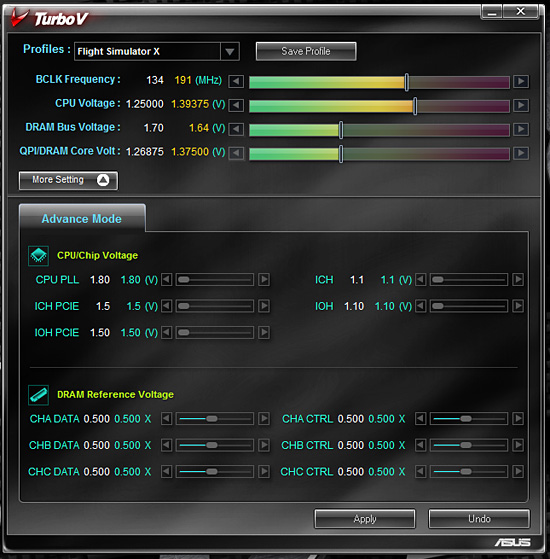
TurboV is ASUS' latest Windows based overclocking utility that features the ability to change most major BIOS settings to improve overclocking rates. It features profiles and works quite well, provided the memory timings and CPU multiplier have been set up properly prior to entering Windows. We are still hopeful that one of the major suppliers will offer the same capabilities as AMD's AOD utility.
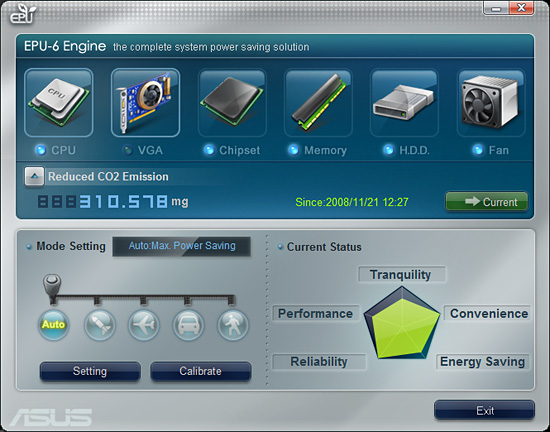
The P6T Deluxe features the EPU-6 power savings technology that can be accessed through the EPU software. The program offers five different modes or levels of energy savings. After hours of testing each setting, we found that leaving the application on Auto with a proper calibration worked best. Utilizing EPU-6 resulted in a power savings of 5W at both idle and load settings.
















78 Comments
View All Comments
Zak - Saturday, December 6, 2008 - link
I still had working PII and PIII mobos that I trashed this year, not because they were bad but because these platforms were outdated. These mobos still worked 100% after what 7-8 years??? Each mobo I bough within the last 3-4 years never lasted more than 2 years without some major malfunction (some controller dying, memory slots failing, etc). The boards are getting more expensive and less reliable. There is an obsession with overclocking without any effort to offer perfect stability. Most users want a good balance of speed and stability, and as we all know one isn't any good without the other. Besides, overclocking yields minimal real life gains, unless you do something really extreme, and how many people do extreme overclocking??? Mobo makers should focus on stability and features first. Eh...We live in beta culture:(Z.
Griswold - Saturday, December 6, 2008 - link
What does AT get for being a quasi outsourced QA branch of these mobo manufacturers? To me it looks like you're being taken advantage of - its great that you work with them to get stuff fixed, but is there any compensation for the time invested other than the good feeling?Syntience - Saturday, December 6, 2008 - link
Some of us have non-parallelizable applications (in our case, a certain kind of AI research) that require vast amounts of memory but don't require that much in the way of processing power. We buy the motherboards with the highest number of memory slots and fill those up with the largest memory modules we can reasonably afford. At the moment (late 2008) that means 4GB DDR2 modules. Boards like SuperMicro H8QMi-2+ have 32 DIMM sockets on the motherboard which means our current sweet spot is 128GB.We expect motherboards to operate in these fully loaded configurations, and so far we've been quite lucky. But we'd appreciate manufacturers and reviewers consistently testing boards in whatever max memory capacity the manufacturer is advertising.
Incidentally, we'd like to see motherboard manufacturers produce systems with DIMM sockets on daughter boards that could be stacked to some depth for even more memory, or even return to backplane/bus based designs with multiple separate memory boards. I don't know whether this is economically feasible to do with current memory interface chip sets. It clearly is possible, since these kinds of systems are available in the turnkey server market.
- Monica
LTG - Saturday, December 6, 2008 - link
What you guys are doing is outstanding and exactly the right thing.What's the saying, sunshine is the best disinfectant?
That's what manufacturers need - as much light as possible shown on their quality and stability issues.
Let the best companies reap the rewards just as the top automakers do with their reliability measures.
DaveLessnau - Saturday, December 6, 2008 - link
The reason manufacturers have thrown reliability, stability, and maintainability (i.e., Quality) out the window is because of the way the review sites review their products. Back in the day, places like PC Magazine would do yearly articles that talked about which manufacturer produced, essentially, the highest quality products. Try to find something like that today. If a board doesn't have glowing fins, can't overclock to a bajillion GHz, use a terabyte of RAM, run 27 video cards in tandem, have every doodad imaginable stuck onto it, roar like a jet-engine because of the cooling requirements, and require a KW-level power supply, the review sites don't even cover it (I'm using an Intel DP45SG right now -- I double-dog dare you to find a review of it anywhere (I mean, it's only a fairly new board from the pre-eminent computer company on the planet)). Plus, every review automatically focuses on the over-clocking aspects of the boards. Overclocking is a fine thing to mention ONCE THE BASIC QUALITY OF THE BOARD AND THE COMPANY BEHIND IT HAS BEEN DETERMINED.For instance, this DP45SG. I bought it for two reasons: 1) it (supposedly) does exactly what I need it to do, and 2) Intel (supposedly) provides good support and reliable boards. There are no reviews out there because it's not an "enthusiast" board from an "enthusiast" company. So, I had to buy it blind. After setting it up, I found that (this is from my Newegg review):
"Under Vista Ultimate (x64), drives connected to the eSATA port on the back do not get recognized as external or removable after the machine has entered and exited sleep mode. Without having slept, there's no problem. I confirmed this with 3 separate drives in 2 external enclosures.
- The Dolby Control Center software doesn't exist in a 64-bit version. I searched Intel's site and the web in general and found nothing. Intel doesn't even know when there will be a 64-bit version.
- The Intel Desktop Control Center software isn't available for the current BIOS. According to the web site: "The current BIOS release for Intel Desktop Board DP45SG does not support the Intel Desktop Control Center. A new version of the Intel Desktop Control Center will be posted here when a compatible BIOS becomes available."
- The Intel Integrator Assistant software isn't available for 64-bit versions of either Vista or XP."
The first three of those bullets are some of the core things I needed. They're advertised for the board, but there are no reviews. So, no one knows about it.
Then, take a look at support. Intel just released a new BIOS for the board (0102). You can take a look at ABXZone in the Intel DP45SG (Skyburg) thread starting on page 38 for comments on this. In a nutshell, Intel released a BIOS that sets processor speeds and voltages wrong and killed SpeedStep if you just LOOKED at the processor settings. Granted, talking to their technical support was somewhat refreshing compared to other companies. But, finally, I (and others) reverted back to the previous BIOS.
The horrifying thing is that this has nowhere to go but down. None of the sites cover this kind of information. So, basic quality just continues to ebb while the companies put more and more focus on the trivial bells and whistles that the "enthusiast" sites focus on.
strikeback03 - Monday, December 8, 2008 - link
I'd guess the most basic answer is that they don't have enough man-hours available to do complete testing on every motherboard available. As far as I can tell, motherboard testing is done by Gary, with some help from Anand and possibly Raja. Guessing by the name of your board, it is a P45-based design. Looking at just ASUS site, they list 12 P45 boards, and based on previous ASUS experience there are probably more which just do not show up properly in the list. How long would it take one or two people to only check basic operation of the 12 listed boards? There are at least two relevant OSes to test under, Vista 32 and 64 bit. Do they test XP as well? Both 32 and 64 bit? How about any forms of Linux, again with both 32 and 64 bit? A previous commenter complained about a certain Logitech keyboard not working, just how many different peripherals should they keep around? And multiply this by however many boards all the other manufacturers have out, and get thm done in time to be relevant before the next chipset revision comes out? For free?As a result I imagine they pick only boards which stand out or they guess will bring the most traffic to the site. This ends up being the overclocking-friendly boards, some uATX boards, and some HTPC friendly boards it seems.
ATWindsor - Saturday, December 6, 2008 - link
Very nice that you focus on stability and things actually working, to many sites give our "recommended"-stmaps in an uncritical fashion even when boards work poorly. This makes the site even more excellent, Goog work!poohbear - Saturday, December 6, 2008 - link
why are u guys accomodating the mobo manufacturers?!?!?! i understand you're one of the bigger review sites, but seriously if the product doesnt work just say that in your review, dont even bother contacting their engineers for help cause they should've taken care of that before it was even released. I dont read your reviews to see who i have to call or where i have to look to get a certain feature on the mobo to work. I know i sure as hell won't be able to call Evga's engineer and ask for help when my $300 mobo doesnt work. Gimme a break. I just want to know if it works out of the box.I'm glad to hear u guys are now going buy a mobo off the shelf to review the same product we all get, but didnt u do that all along?!!? its pretty disturbing to think u have always been reviewing cherry picked products. i'll have to read your reviews with a grain of salt UNLESS you specifically state where you got the product from. Didnt it ever occur to you that the products the manufacturer sends to u might have been unfairly optimized??
thorgal73 - Saturday, December 6, 2008 - link
... motherboard makers that don't care about finishing their products before they come to the market, that is.A simple example is DFI, but lately even the tier 1 manufacturers are guilty of it. I personally pulled al lot of my hair out while reviewing the DFI X48-T3RS over at Madshrimps.be. I've spent 2 months on that one, before I had anything decent to write about, and even now the review feels incomplete.
Did any of you notice that there never was a DFI X48-T3RS review here at Anand ? There was a preview with the Corsair 2133 memory, but the promised review never made it. Now you understand why...
I can only side with Anand here that something needs to be done urgently. I myself am as sick and tired than any other reviewer to spend ages on a review, while having my boss at my back asking "what's taking so long" ;-) I agree with the opinion that unfinished boards do not deserve publication, problem is, no boards that we (reviewers) get in our hands are finished, as they're mostly rev. 1.0 (or worse) with very early biosses.
Only solution is waiting with the risk that other sites will beat you to the review, and your own review will barely surface on the web any more....
danger22 - Saturday, December 6, 2008 - link
you should refuse to publish articles with boards that don't work out of the box. why give them any publicity?